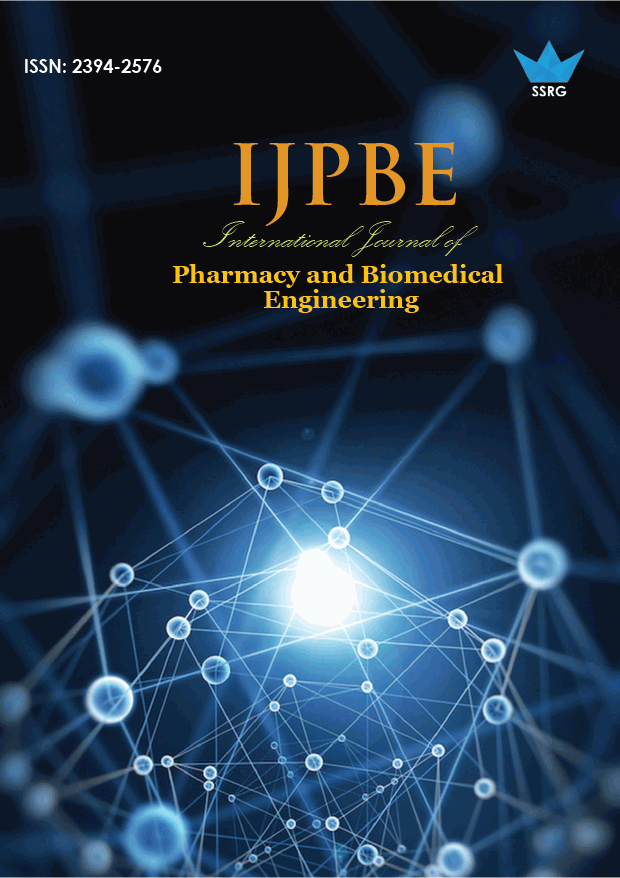Development of Dithranol overloaded hard Lipid Nanoparticles

| International Journal of Pharmacy and Biomedical Engineering |
| © 2015 by SSRG - IJPBE Journal |
| Volume 2 Issue 3 |
| Year of Publication : 2015 |
| Authors : C.Anahera and S.Kahurangi |
How to Cite?
C.Anahera and S.Kahurangi, "Development of Dithranol overloaded hard Lipid Nanoparticles," SSRG International Journal of Pharmacy and Biomedical Engineering, vol. 2, no. 3, pp. 5-8, 2015. Crossref, https://doi.org/10.14445/23942576/IJPBE-V2I3P102
Abstract:
Dithranol belongs to the keratolytic category, which is a widely used drug in the treatment of psoriasis. The drug is virtually inexplicable in water. Many conservative quantity forms for psoriasis treatment have been formulated earlier, but they did not show good results. Hence in the present study, it was attempted to invent dithranol in the form of solid lipid nanoparticle. Solid lipid nanoparticles of dithranol were obtained by alteration of lipid spreading method. Preformulation studies were performed to check the compatibility of drug and excipient for the development of formulation by DSC, and no statement was found. Solubility study, division coefficient purpose, UV examination, HPLC study, FTIR study were also performed. After the preformulation studies dithranol loaded solid lipid nanoparticles was also prepared. Hence it was concluded that solid lipid nanoparticle of dithranol could be formulated.
Keywords:
dithranol, psoriasis, solid lipid nanoparticle, preformulation studies.
References:
[1] Katare Prakash Om, Raza Kaisar, Singh Bhupinder, Dogra Sunil, “Novel drug delivery systems in the topical treatment of psoriasis: Rigors and vigors”, Indian Journal Of Dermatology, Venereology and Leprology, 2010;76:612-621.
[2] Rawat, M.K., Jain, A., Mishra, A., Muthu, MS., Singh, S.(2010): “Studies on development repaglinide loaded solid lipid nanoparticles: effect of lipid matrix”. Therapeutic delivery 2010;1:63-73.
[3] J. Coffey, MD, I. Landells, MD, FRCPC Topical Treatment of Psoriasis in Children, Skin Therapy Letter (September 2010).
[4] Indian Pharmacopoeia 2007 published by the Ministry of Health and Family Welfare (India)Government of India
[5] Gomes Cristiani Greici & Salgado Nunes Regina Hérida, Validation of UV Spectrophotometric, Method for Determination of Lomefloxacin in Pharmaceutical Dosage Form, Acta Farmacéutica Bonaerense, 2005;24:24-35
[6] Chakravarthy D, Kumar Prasanth K, Srikanth AU, Bhanuteja Bulusu, Basha Peer D, Method development and Validation of Reverse Phase HPLC Method for the determination of Dithranol in Pharmaceutical Ointment Forms, International Journal of Chemical and Analytical Science, 2011;2:73-78.
[7] Monographs: Pharmaceutical substances: Dithranolum – Dithranol. International Pharmacopoeia published by World Health Organization Geneva.
[8] Cafaggi S, Vallarino M, Caviglioli G, Parodi B, Bignardi G, Study of the interaction of dithranol with heptakis(2,3,6-tri-Omethyl)-beta-cyclodextrin in solution and the solid-state. Journal Of Pharmacy And Pharmacology, 1998;50:257-64.
[9] Brown, R. J. C. & R. F. C. "Melting Point and Molecular Symmetry". Journal of Chemical Education 200;77: 724
[10] Lyman W.J., Reehl W.F and Rosenblatt D.H., “Handbook of Chemical Property Estimation Methods”, McGraw- Hill, New York, 1983.
[11] Test Method Protocol for Solubility Determination September 24, 2003U. S. Environmental Protection Agency. 1996. Product Properties Test Guidelines. OPPTS 803.7840. Water Solubility: Column Elution Method; Shake Flask Method. EPA712-C-96-041, Prevention, Pesticides and Toxic Substances, Washington DC.
[12] Tripathi G and Dubey B.K., “In-vitro occlusion studies of solid lipid nanoparticles loaded hydrogel by water vapour permeability analysis”, Journal of Global Pharma Technology 2011: 3:14‐20.

 10.14445/23942576/IJPBE-V2I3P102
10.14445/23942576/IJPBE-V2I3P102